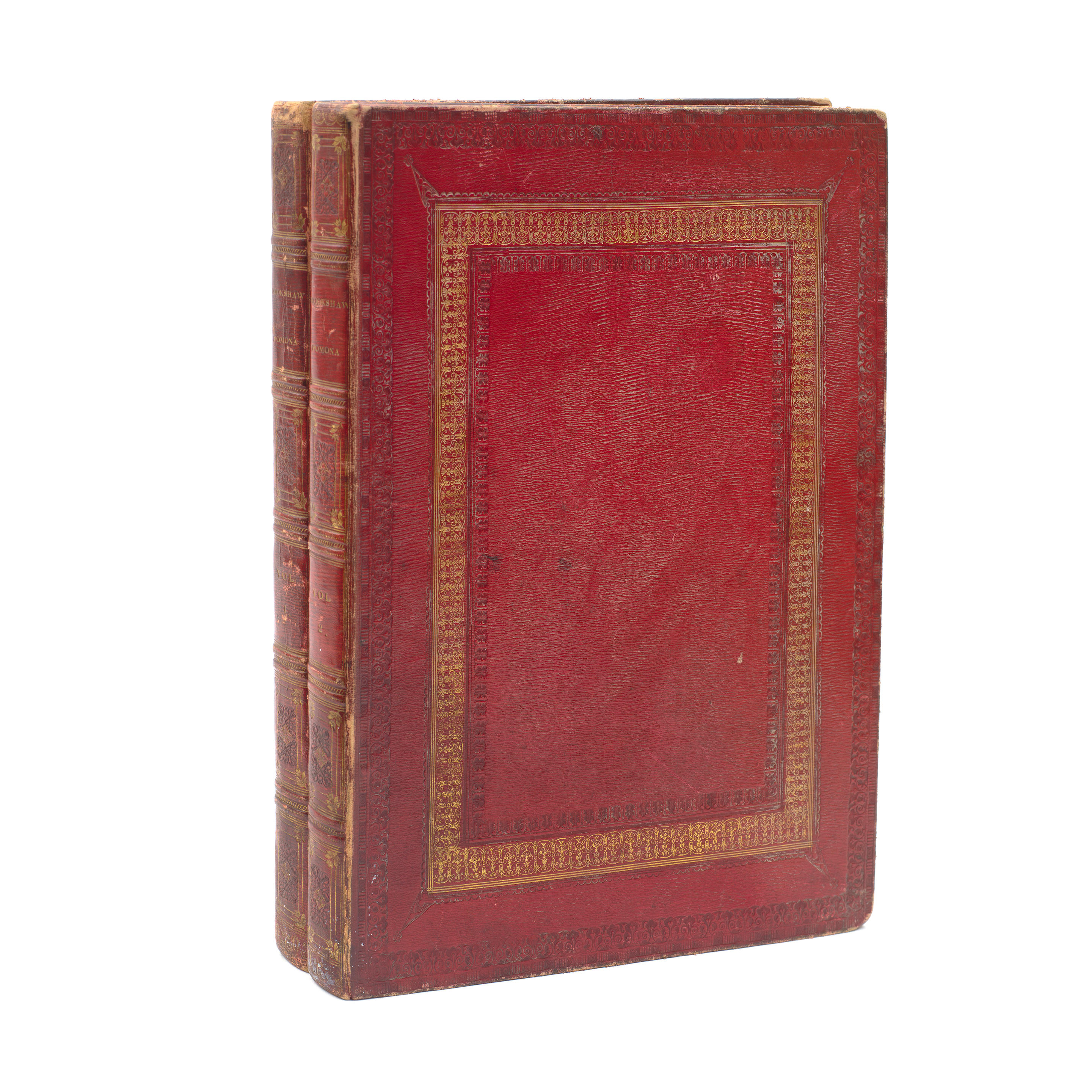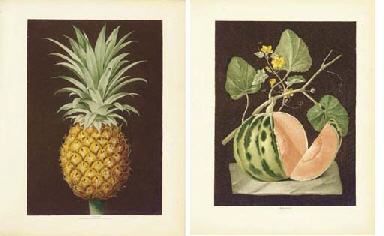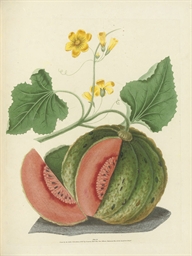BROOKSHAW, George. Pomona Britannica; or, a collection of the most esteemed fruits at present cultivated in this country. London: T. Bensley for the author, published by White, Cochrane and Co., E. Lloyd and W. Lindsell, [1804-]1812. Large broadsheets (575 x 455mm). 90 AQUATINT AND STIPPLE-ENGRAVED PLATES BY G. BROOKSHAW, PRINTED IN COLOUR AND FINISHED BY HAND, with the author's printed slip explaining the absence of three pineapple plates, 1 page index. (Vertical crease to title and last leaf, both laid down, vertical crease to dedication leaf, lower outer corner of title and first six leaves neatly repaired, 30mm tear in lower blank margin of plate XVI, slight spotting to plates I, VIII, LIV and LXXV, slight offsetting onto plates XLVII, LI, LV.) Contemporary red straight-grained morocco, covers panelled in gilt and blind, with a central blind strap-work panel decorated with various small tools, various outer panels made up from multiple fillets and various roll-tools, the spine with a repeat pattern in gilt and blind, gilt turn-ins, g.e. (spine slightly rubbed, joints strengthened, corners neatly repaired, modern doublures and endleaves), slipcase. A FINE COPY OF THE FIRST EDITION OF THE FINEST ENGLISH WORK ON FRUIT. The binding remains unidentified, but appears to share a quite distinctive roll with item 157 in Maggs cat.893 (also unidentified). 256 varieties of fruit are depicted in the 90 plates, the subjects include 7 plates of Cherries; 10 of Plums or Apricots; 15 of Peaches and Nectarines; 5 of Pineapples; 17 of Grapes; 9 of Melons, 11 of Pears and 7 of Apples. They were engraved by Richard Brookshaw and H. Merke (plate 48). Richard Brookshaw probably the author's elder brother, was a mezzotint engraver who found popularity in France; his plates in the Pomona , dated 1804, are his last recorded works. The Pomona marked the re-emergence of George Brookshaw into the public eye after a total disappearance of nearly a decade. Until recently, little has been known of Brookshaw's life, but in a recent article ("George Brookshaw: The case of the vanishing cabinet-maker", Apollo , May 1991) Lucy Wood has uncovered many details in the remarkable story of a man who began his career as a celebrated cabinet-maker and died a relatively unappreciated botanical artist, and who seems to have deliberately obscured many of the connections between his two personae. Brookshaw, born in Birmingham and married to the daughter of a prosperous Birmingham gunsmith, moved to London in 1777 to embark on a career as a cabinet-maker. By 1783 he had attracted the patronage of the Prince of Wales and other prominent members of society: his furniture was noted for its painted decoration with figurative, landscape and, above all, floral themes. An inscription on one of his bills presented to the Prince of Wales in 1783 describes him as a 'Peintre Ebéniste par Extraordinaire'. However, no record survives of any furniture made by him after the mid-1790s. Lucy Wood suggests that a financial or sexual scandal drove him to live and work under a false name and precipitated his embarkation on an entirely new career. She believes that A New Treatise on Flower Painting , published anonymously in 1797 and later (in the third edition of 1799) in the name of G. Brown, was actually by Brookshaw, whose A Supplement to the Treatise on Flower Painting published in 1817 has largely the same content - including 11 plates supposedly by Brookshaw but identical to those in the earlier work, where they are attributed to Brown. The Pomona was first issued in parts from 1804 to 1808 (apart from two plates dated 1812). The first edition of the complete work was published in 1812 and was dedicated to the Prince Regent, Brookshaw's most distinguished former patron. Many of the specimens were taken from the Royal Gardens at Hampton Court and Kensington Gardens. Other gardens mentioned in the text are those of the Princess of Wales at Blackheath, the Duke of York at Oatlands
BROOKSHAW, George. Pomona Britannica; or, a collection of the most esteemed fruits at present cultivated in this country. London: T. Bensley for the author, published by White, Cochrane and Co., E. Lloyd and W. Lindsell, [1804-]1812. Large broadsheets (575 x 455mm). 90 AQUATINT AND STIPPLE-ENGRAVED PLATES BY G. BROOKSHAW, PRINTED IN COLOUR AND FINISHED BY HAND, with the author's printed slip explaining the absence of three pineapple plates, 1 page index. (Vertical crease to title and last leaf, both laid down, vertical crease to dedication leaf, lower outer corner of title and first six leaves neatly repaired, 30mm tear in lower blank margin of plate XVI, slight spotting to plates I, VIII, LIV and LXXV, slight offsetting onto plates XLVII, LI, LV.) Contemporary red straight-grained morocco, covers panelled in gilt and blind, with a central blind strap-work panel decorated with various small tools, various outer panels made up from multiple fillets and various roll-tools, the spine with a repeat pattern in gilt and blind, gilt turn-ins, g.e. (spine slightly rubbed, joints strengthened, corners neatly repaired, modern doublures and endleaves), slipcase. A FINE COPY OF THE FIRST EDITION OF THE FINEST ENGLISH WORK ON FRUIT. The binding remains unidentified, but appears to share a quite distinctive roll with item 157 in Maggs cat.893 (also unidentified). 256 varieties of fruit are depicted in the 90 plates, the subjects include 7 plates of Cherries; 10 of Plums or Apricots; 15 of Peaches and Nectarines; 5 of Pineapples; 17 of Grapes; 9 of Melons, 11 of Pears and 7 of Apples. They were engraved by Richard Brookshaw and H. Merke (plate 48). Richard Brookshaw probably the author's elder brother, was a mezzotint engraver who found popularity in France; his plates in the Pomona , dated 1804, are his last recorded works. The Pomona marked the re-emergence of George Brookshaw into the public eye after a total disappearance of nearly a decade. Until recently, little has been known of Brookshaw's life, but in a recent article ("George Brookshaw: The case of the vanishing cabinet-maker", Apollo , May 1991) Lucy Wood has uncovered many details in the remarkable story of a man who began his career as a celebrated cabinet-maker and died a relatively unappreciated botanical artist, and who seems to have deliberately obscured many of the connections between his two personae. Brookshaw, born in Birmingham and married to the daughter of a prosperous Birmingham gunsmith, moved to London in 1777 to embark on a career as a cabinet-maker. By 1783 he had attracted the patronage of the Prince of Wales and other prominent members of society: his furniture was noted for its painted decoration with figurative, landscape and, above all, floral themes. An inscription on one of his bills presented to the Prince of Wales in 1783 describes him as a 'Peintre Ebéniste par Extraordinaire'. However, no record survives of any furniture made by him after the mid-1790s. Lucy Wood suggests that a financial or sexual scandal drove him to live and work under a false name and precipitated his embarkation on an entirely new career. She believes that A New Treatise on Flower Painting , published anonymously in 1797 and later (in the third edition of 1799) in the name of G. Brown, was actually by Brookshaw, whose A Supplement to the Treatise on Flower Painting published in 1817 has largely the same content - including 11 plates supposedly by Brookshaw but identical to those in the earlier work, where they are attributed to Brown. The Pomona was first issued in parts from 1804 to 1808 (apart from two plates dated 1812). The first edition of the complete work was published in 1812 and was dedicated to the Prince Regent, Brookshaw's most distinguished former patron. Many of the specimens were taken from the Royal Gardens at Hampton Court and Kensington Gardens. Other gardens mentioned in the text are those of the Princess of Wales at Blackheath, the Duke of York at Oatlands


.jpg)










.jpg)
Try LotSearch and its premium features for 7 days - without any costs!
Be notified automatically about new items in upcoming auctions.
Create an alert